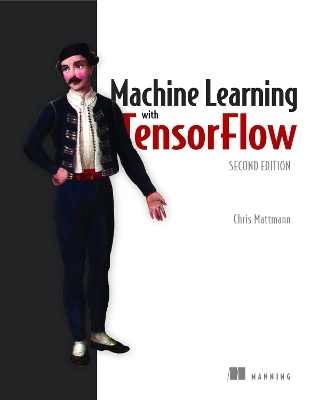
Machine Learning with TensorFlow
Manning Publications (Verlag)
978-1-61729-771-7 (ISBN)
- Titel z.Zt. nicht lieferbar
- Versandkostenfrei innerhalb Deutschlands
- Auch auf Rechnung
- Verfügbarkeit in der Filiale vor Ort prüfen
- Artikel merken
New and revised content expands coverage of core machine learning algorithms and advancements in neural networks such as VGG-Face facial identification classifiers and deep speech classifiers. Written by NASA JPL Deputy CTO and Principal Data Scientist Chris Mattmann, all examples are accompanied by downloadable Jupyter Notebooks for a hands-on experience coding TensorFlow with Python.
Key Features
· Visualizing algorithms with TensorBoard
· Understanding and using neural networks
· Reproducing and employing predictive science
· Downloadable Jupyter Notebooks for all examples
· Questions to test your knowledge
· Examples use the super-stable 1.14.1 branch of TensorFlow
Developers experienced with Python and algebraic concepts like
vectors and matrices.
About the technology
TensorFlow, Google’s library for large-scale machine learning, makes powerful ML techniques easily accessible. It simplifies often-complex computations by representing them as graphs that are mapped to machines in a cluster or to the processors of a single machine. Offering a complete ecosystem for all stages and types of machine learning, TensorFlow’s end-to-end functionality empowers machine learning engineers of all skill levels to solve their problems with ML.
Chris Mattmann is the Deputy Chief Technology and Innovation Officer at NASA Jet Propulsion Lab, where he has been recognised as JPL's first Principal Scientist in the area of Data Science. Chris has applied TensorFlow to challenges he’s faced at NASA, including building an implementation of Google’s Show & Tell algorithm for image captioning using TensorFlow. He contributes to open source as a former Director at the Apache Software Foundation, and teaches graduate courses at USC in
Content Detection and Analysis, and in Search Engines and Information Retrieval.
Nishant Shukla wrote the first edition of Machine Learning with TensorFlow.
Chris Mattmann is the Deputy Chief Technology and Innovation Officer at NASA Jet Propulsion Lab, where he has been recognised as JPL's first Principal Scientist in the area of Data Science. Chris has applied TensorFlow to challenges he’s faced at NASA, including building an implementation of Google’s Show & Tell algorithm for image captioning using TensorFlow. He contributes to open source as a former Director at the Apache Software Foundation, and teaches graduate courses at USC in Content Detection and Analysis, and in Search Engines and Information Retrieval. Nishant Shukla wrote the first edition of Machine Learning with TensorFlow.
table of contents PART 1. YOUR MACHINE-LEARNING RIG READ IN LIVEBOOK 1A MACHINE-LEARNING ODYSSEY READ IN LIVEBOOK 2TENSORFLOW ESSENTIALS PART 2. CORE LEARNING ALGORITHMS READ IN LIVEBOOK 3LINEAR REGRESSION AND BEYOND READ IN LIVEBOOK 4USING REGRESSION FOR CALL-CENTER VOLUME PREDICTION READ IN LIVEBOOK 5A GENTLE INTRODUCTION TO CLASSIFICATION READ IN LIVEBOOK 6SENTIMENT CLASSIFICATION: LARGE MOVIE-REVIEW DATASET READ IN LIVEBOOK 7AUTOMATICALLY CLUSTERING DATA READ IN LIVEBOOK 8INFERRING USER ACTIVITY FROM ANDROID ACCELEROMETER DATA READ IN LIVEBOOK 9HIDDEN MARKOV MODELS READ IN LIVEBOOK 10PART-OF-SPEECH TAGGING AND WORD-SENSE DISAMBIGUATION PART 3. THE NEURAL NETWORK PARADIGM READ IN LIVEBOOK 11A PEEK INTO AUTOENCODERS READ IN LIVEBOOK 12APPLYING AUTOENCODERS: THE CIFAR-10 IMAGE DATASET READ IN LIVEBOOK 13REINFORCEMENT LEARNING READ IN LIVEBOOK 14CONVOLUTIONAL NEURAL NETWORKS READ IN LIVEBOOK 15BUILDING A REAL-WORLD CNN: VGG -FACE AND VGG -FACE LITE READ IN LIVEBOOK 16RECURRENT NEURAL NETWORKS READ IN LIVEBOOK 17LSTMS AND AUTOMATIC SPEECH RECOGNITION READ IN LIVEBOOK 18SEQUENCE-TO-SEQUENCE MODELS FOR CHATBOTS READ IN LIVEBOOK 19UTILITY LANDSCAPE READ IN LIVEBOOK APPENDIX A: INSTALLATION INSTRUCTIONS
| Erscheinungsdatum | 25.01.2021 |
|---|---|
| Verlagsort | New York |
| Sprache | englisch |
| Maße | 185 x 234 mm |
| Gewicht | 820 g |
| Themenwelt | Informatik ► Theorie / Studium ► Algorithmen |
| ISBN-10 | 1-61729-771-2 / 1617297712 |
| ISBN-13 | 978-1-61729-771-7 / 9781617297717 |
| Zustand | Neuware |
| Haben Sie eine Frage zum Produkt? |
aus dem Bereich



